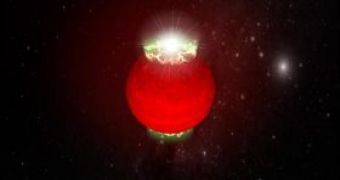Brown dwarfs are enigmatic space objects that are too small to be stars but too large to be planets. They are sometimes called "failed stars" because they have too little mass to trigger hydrogen fusion reactions at their cores, the source of the energy output in larger stars. With roughly 15 to 80 times the mass of Jupiter, the largest planet in our Solar System, brown dwarfs were long thought to exist. However, it was not until 1995 that astronomers were able to actually find one. A few dozens now are known.
Gregg Hallinan of the National University of Ireland, Galway, presented a study revealing that brown dwarfs or 'failed stars' as they are known, can possess powerful magnetic fields and emit lighthouse beams of radio waves thousands times brighter than any detected so far from the Sun.
They seem to behave like pulsars and might eventually help astronomers understand how pulsars produce radio emissions.
"Brown dwarfs tend to be seen as a bit boring - the cinders of the galaxy. Our research shows that these objects can be fascinating and dynamic systems, and may be the key to unlocking this long-standing mystery of how pulsars produce radio emissions," said Hallinan.
Since the discovery of pulsars forty years ago, astronomers have been trying to understand how the rotating neutron stars produce their flashing radio signals.
Although there have been many attempts to describe how they produce the extremely bright radio emissions, the vast magnetic field strengths of pulsars and the relativistic speeds involved make it extremely difficult to model.
Brown dwarfs, researchers say, are the second class of stellar object observed to produce this kind of powerful, amplified (coherent) radio signal at a persistent level. The emissions from the brown dwarfs appear to be very similar to those observed from pulsars, but is on a much slower and smaller scale, making it easier to decipher exactly what is going on.
Importantly, the mechanisms for producing the radio emissions in brown dwarfs are well understood, as they are almost identical to the processes that produce radio emissions from planets. "It looks like brown dwarfs are the missing step between the radio emissions we see generated at Jupiter and those we observe from pulsars," Hallinan added.
The group of researchers observed the brown dwarf, TVLM 513, using the Very Large Array (VLA) radio telescope, over a period of 10 hours at two different frequencies. In both cases, a bright flash was observed every 1.96 hours.
Hallinan stated that "The processes controlling the radio flashes from TVLM 513 are still unclear and since there is no evidence of a binary system, so interaction of the magnetosphere with a stellar wind from a nearby star also seems an unlikely cause. Nor is there any sign of an orbiting planet that could produce a scenario like that of Jupiter and Io. However, rapid rotation is also thought to be a source of electron acceleration for a component of Jupiter's maser emission and this may also be the main source of TVLM 513's radio flashes."
The group is now planning a large survey of all the known brown dwarfs in the solar neighborhood to find out how many are radio sources and how many of those are pulsing. If a large fraction of brown dwarfs are found to pulse, it could prove a key method of detection for these elusive objects.

 14 DAY TRIAL //
14 DAY TRIAL //